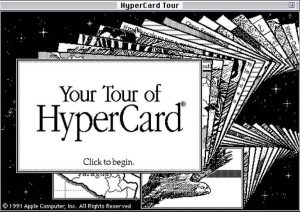In their exploration of CD-ROM histories, the CD-Hist project team interviewed Florian Brody, one of the first users of CD-ROM drives in Europe, the head of The Voyager’s Expanded Books project, as well as both a practitioner and a theorist in digital media. The interviews, conducted on July 29 and August 22, led Alina Volynskaya to investigate deeper in how Apple’s HyperCard application played a crucial role in the development of early CD-ROM projects.
HyperCard allowed users to create “stacks of cards”, each containing different types of media—text, images, sound, buttons, and menus. Users could navigate between different media and follow their own paths of exploration. For instance, the well-known CD companion to Beethoven’s Symphony No. 9, one of the first interactive CDs released by the Voyager Company in 1989, allowed users to freely navigate between different sections of the symphony and switch between the music and the accompanying commentary.
Often described as a “hypermedia construction kit,” HyperCard was one of the earliest technological implementations of the visions surrounding interactivity and hypermedia. However, a single application was not enough to make interactivity a widespread practice; a substantial storage solution was also required—something that computers of the time could not provide. This is where CD-ROMs came in, offering 650 MB of storage at a time when most computers had hard drives of only 40 MB or less. The combination of HyperCard and CD-ROM technology afforded the creation of some of the earliest“interactive” and “multimedia” digital artifacts, which have now become classics, including Myst (1993), the Voyager’s interactive projects, The Whole Earth Catalog CD-ROM (1988), and early multimedia encyclopedias. Revisiting these classic CD-ROMs and examining the technologies that made them possible offers new ways to think about histories of interactivity and histories of computing at large.
Further reading on HyperCard:
- “The Freedom to Associate” – The Digital Antiquarian blog
- “Computer Chronicles Revisited 92 – HyperCard, Focal Point, and the National Gallery of Art Laserguide” – Blog post by Steve Moliva
- The Computer Chronicles video on HyperCard (1987)
- HyperCard Tour (1991)
HyperCard in the Internet Archive:
- Episode on HyperCard
- The Complete HyperCard Handbook (1988)
- Emulation of the early version of the HyperCard program for Macintosh
Image source: Internet Archive
